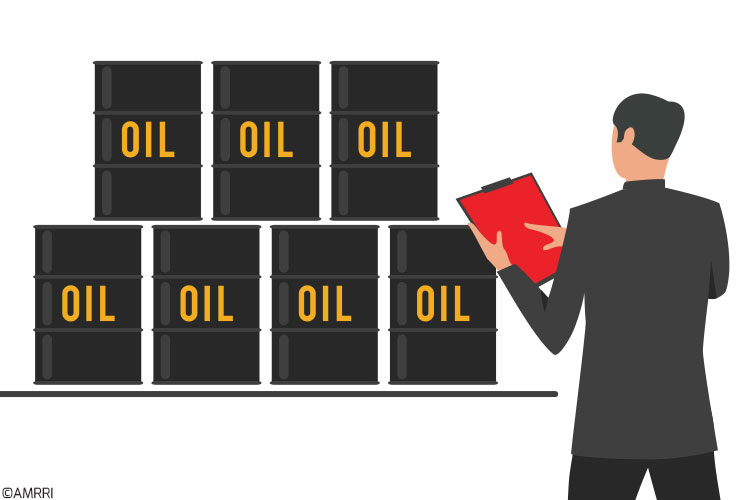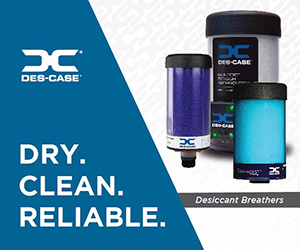Lubricants are often thought of as a machine’s lifeblood. To protect machine investment and perform as designed, their needs and end-user requirements must be understood and met with diligence. Getting the most out of your lubricants requires a lubrication management strategy.
A Lubrication Management Implementation
In a best practice lubricant management program, a lubricant begins life as base oil refined from mineral crude or synthesized stocks, into which various specialty additives are blended. Those additives make up the proprietary lubricant product ready for delivery to market.
From the refiner/manufacturer, the finished lubricant is transferred into bulk containers and starts its journey to the market supplier, which offloads the bulk oil into its storage tanks. Once the oil is sold to the end-user, it’s transferred and delivered in various pre-packaged vessels/containers, i.e., pails, drums, and totes. Alternatively, it is transferred into a bulk container/truck for delivery and into the end-user’s bulk storage totes.
The lubricant is then stored at the end-user’s facility in a general or specialized stock/containment area. When required, the product is again transferred into smaller, more convenient containers, transported to specific machines, and put into their reservoirs.
When a lubricant is no longer deemed fit for use, it’s siphoned or drained from a machine’s reservoir and collected in select used oil containers. The lubricant is then classified and stored separately in a temporary holding space from which it will be sent to a re-refiner for recycling into marketable oil stocks.
Each time a lubricant is stored or transferred before use in a machine, it’s at risk for solids and water contamination, which are highly detrimental to bearings. As end-users, we gain control of lubricant cleanliness when we receive it from the supplier.
Our success in controlling that cleanliness is achieved through an effective in-house lubricant storage and handling program. (Before a site receives a lubricant, it can exercise cleanliness control through an audited purchase program with the supplier.)

Document Your Current Lubrication Management State
Designing and building an appropriately sized and outfitted world-class lubricant management storage and handling facility requires the end user to understand three requirements from the onset:
- All of the plant’s lubrication requirements
- The logistical requirements for efficient storage and movement of lubricants throughout the plant
- Corporate, Federal, and State sustainability and environmental stewardship requirements
Understanding Your Lubrication Requirements
Foundational to any lubricant management program is assuring the right lubricant choice is made for each end-user machine. This decision is ideally based on actual machine operating conditions, associated working environment factors, performance, and economy.
Choosing the proper lubricant is a specialized task that’s often best left to lubricant engineering experts. Fortunately, virtually all major lubricant manufacturers and their suppliers offer the end-user some form of lubricant-engineering service(s).
This involves an audit in which one or more lubricant engineers visit a site to determine the least number of lubricant types suited to the end-user’s working environment and engineering requirements. This lubricant-consolidation service is a mandatory requirement of any lubrication management program.
In preparation for a consolidation audit, the maintenance department can facilitate the process by compiling information for all assets requiring lubrication that will include as much of the following as possible:
- List of all machines/equipment that employ/use lubricants (oil, grease, pastes, waxes)
- General assembly drawings of equipment
- Operating schedules for all lubricated machinery
- Lubrication schematics for automated and manual lubrication points. (If unavailable, consider preparing 1-D and 3-D lubrication system schematic sketches for each machine system. Number each bearing point and line and identify any existing lubrication settings, if known.)
- Gearbox specifications
- Hydraulic-system specifications
- Bills of Material (bearing take off, lubrication-system components)
- List of equipment already employing thermostat-controlled reservoir-heating devices and/or lubrication-line heat tracing
- Operations and maintenance (O&M) manuals
- Photographs of installed lubrication systems
- Recommended lubricant list for all lubrication points and systems
- An actual list of current lubricants used on all lubrication points and systems
- Machine warranties still in effect (Check to see if using a non-recommended lubricant equivalent affects the machine warranty.)
- OEM lubricant system flushing procedure(s), if known
- List, location, and inventory of all lubricants found on-site list of all active lubricants on the approved corporate-purchase list
- Copy of lubricant purchase history for the previous three years
- Copies of all Safety Data Sheets for on-site lubricants
- Drawings of the current lubricant storage facility/area(s)
- Copy of current corporate sustainability/environment/toxicity requirements
- List of corporate restrictions on lubricant, lubricant type purchases
- Copy of the current lubricant supplier agreement.
With your current lubricant usage and documentation, the third-party consolidation engineering team can accurately assess your asset needs based on usage patterns and purchase history.
Similarly, the operation and ambient working conditions are also assessed to evaluate the best lubricant choice for each lubricated asset. The deliverable from that assessment is a tailored list of consolidated lubricants that can be supplied at a guaranteed cost and quality.
If, for some reason, the consolidator cannot match a highly specialized or warranty-required lubricant, the existing choice of the supplier/manufacturer is then recommended for purchase outside of the consolidation agreement.
Many consolidation audits are offered as a no-cost, value-added service in return for an exclusive (multi-year) lubricant-supply contract. Consolidation exercises have considerably lowered costs by reducing the number of different products a site carries in stock.
A typical plant can stock up to 20 lubricant types (sometimes more), which can often be reduced by 50% (or more) depending on the type of operation. This translates into immediate savings in operating capital, storage and handling, and administrative costs.
In addition, through improved lubrication knowledge and management, improvements in bearing life expectancy and energy reduction are much easier to attain.
Throughout the consolidation process, all unwanted and unused open and closed lubricant containers can be collected for recycling, as only the consolidated lubricants are to be allowed on site once the program is activated.

Consolidate and Prepare Your Storage Facility
Specifications for the storage/dispensing area can be developed with a consolidated lubricant list. To ensure the facility can accommodate the plant’s lubricant needs, these details must be verified:
- Number of different lubricant products to be carried, stored, and dispensed
- Anticipated usage amounts for each lubricant (information that’s used to recommend the most economical purchase method and storage-container size, as well as determine the following needs):
- Real-estate requirements for a 3-to-6-month supply of each lubricant (2 to 3 inventory-turn cycles per year) to ensure fresh product is always available.
- Type and amount of filtering, dispensing, and transfer equipment to ensure only
- Contamination-free lubricants end up in bearing-surface areas.
- In-plant geography of where each lubricant is to be used (information used to determine economical lube routes and logistical requirements, number of lubrication technicians required, lube truck, forklift, lubricant-delivery equipment for getting the right lubricant(s) to the right machine(s).
- SDS (Safety Data Sheets) for all lubricants to determine the storage and handling requirements and the required safety equipment.
Location And Size
As with any real estate, a good location is paramount for a lubricant storage and handling facility (and logistically necessary for receiving lubricants and dispatching them throughout the plant). Large plants may require controlled satellite locations.
Equally important is protecting virgin stock lubricants from the outside elements. Extreme temperatures (hot and cold) and large temperature swings promote moisture condensation in containers. Wind and rain risk solids and water contamination if lubricant containers aren’t stored and/or handled with care before opening for lubricant transfer.
All locations must be rated for and large enough to allow forklift and lube-truck traffic to operate within and around their confines. Temperature- and humidity-controlled indoor locations are preferred and must be large enough to house enough inventory to ensure the lubricant is always fresh and available. Ideal locations allow for bulk delivery and recycle-truck access.
Ventilation
Because lubricants can discharge vapors that might be harmful if allowed to accumulate, a good, motorized-fan crossflow ventilation system consisting of fresh-air units and exhaust-fan units is required for all indoor facilities.
Enclosed outdoor facilities may require similar crossflow ventilation if the building cannot use prevailing wind vents open to air (vents should be filtered using a furnace-style filter) complemented with exhaust-fan units.
Fixtures
Based on the lubricant turnover rate and storage-container economics, storage, and handling facilities may accommodate a variety of containment devices that may include:
- 300-gallon poly totes for bulk oil distribution
- Custom, color-coded steel tank bulk-oil storage and dispensing units/systems
- Drum racks designed to take palletized drums in the upright position, or drum-dispensing racks set on “bunded” (spill-control platforms/catchment trays) with the drum positioned on its side in the rack, complete with a dispensing/metering valve system
- Pails for lesser-used lubricants stacked on bunded pallets similar to stacked drums.
Transfer/Filtration Equipment
To move lubricants to machines, maintenance personnel must transfer them from one container to another in the most non-contaminable way possible.
For bulk containers, using dedicated transfer/filter cart style dispensing units will ensure lubricant is moved from bulk and pre-packaged supplier containers to the machine reservoirs and/or dedicated closed-pour containers for transfer to lube-system reservoirs.
Spill Control
The best practice is to slope storage room floors to a low-point drain, where spilled product can be collected into an easily accessible common waste tank for removal. Spilled lubricants can also be captured within a bermed-capture area on the floor or in a bunded-capture spill tray.
In most countries and U.S. states, mixed used oil and all spilled oil are to be classified, documented, and treated as hazardous waste that cannot be recycled. Local spills can be managed with dry-spill absorbent products that must also be treated as hazardous waste. For hazardous-waste-compliance procedures, always contact your lubricant supplier or local industrial-waste authorities.
Safety
A permanently installed and tested eyewash station is necessary for petroleum-based products. Up-to-date Safety Data Sheet (SDS) binders and Standard Operating Procedures are to be posted at the entrance to the facility.
Stock Control
Most lubricants are only rated for a 6-to-12-month shelf life. Stock must be rotated regularly following a FIFO (First in/First Out) approach. Past-due-date lubricants should be returned to the supplier or recycled, and the stock purchasing/usage history should be evaluated and adjusted accordingly.
Always ensure your lubricant-storage facility is designed large enough to accommodate stock rotation safely when using lifting aids such as a forklift or pallet truck.
Used Oil Control
Mixed used oil is treated as hazardous and can be ten times more expensive than recycled oil to ship off-site. Each lubricant used in the plant will require dedicated collection tanks/totes clearly marked for their respective types, the only exception being waste oil.
Used oil will likely be transported to the storage and handling facility in several container sizes. These must also be clearly identified for only dedicated use with one lubricant type. These containers must be disposed of when no longer required according to local municipal and state requirements.
Since oily rags can self-combust in a regular garbage can, always collect them in a marked fireproof trash can and treat them as hazardous waste.
Identification
Having gone to the trouble of consolidating your lubricants, clearly identify a dedicated area in the facility for each. Use large labels or stencil-mark containers with information identifying each lubricant in large letters (2 to 3 inches high).
Develop a plan-drawing of the facility to identify locations of each lubricant’s assigned area and positions of the waste-oil tank(s) and hazardous-material collection bin.
All lubricant dispensing and collection must be logged and accounted for in compliance with most sustainability and environmental program requirements.
Processes And Procedures
Best practices are rooted in the design and the sustainable operation of lubricant storage and facility. Be sure to develop, map out, and train all staff on all processes and procedures related to the use of the facility.

Manage Your Lube Products for Peak Performance
Before a lubricant can begin the work it was designed to do at the machine level, it must be transferred numerous times. There are four specific phases in which a lubricant is susceptible to avoidable contamination. As listed below, they all are under the control of the end-user maintenance department:
- Before end-user receipt and acceptance from the oil manufacturer/supplier
- While in maintenance storage, awaiting application in the end-user facility
- During transfer from maintenance storage to the machine in the end-user facility
- In use in the facility’s equipment.
In each phase, the end-user maintenance department plays a significant role in avoiding, managing, and controlling lubricant contamination.
Phase 1. Accepting Lubricants into The Plant
To make sure your supplier provides the cleanest lubricant(s) product possible, follow these simple rules before accepting bulk deliveries in your new storage and handling facility (i.e., lube room):
- Insist on receiving a lubricant Certificate Of Analysis (COA) for each product delivered, and keep this document on file until the batch of lubricant has been used.
- Never assume all lubricants are delivered per their COS document specification.
- Set up a delivery-acceptance agreement with the supplier to deliver lubricant based on the COA and/or a set of internal minimum cleanliness (see Table 1 of ISO 4406:1999 Guidelines) and viscosity specifications (within +/- 10% of COA specification).
- Establish an oil quality analysis test acceptable to the end-user and supplier and develop a service-level agreement that outlines lubricant-condemning levels and remedial action requirements should products fail the quality test on delivery.
- Perform quality testing regularly by taking a bulk sample after the tanker truck lines have been flushed before transfer and from the center of any supplier pre-filled containers.
Once new lubricants are in place, the end-user must perform several updates to manage them. This includes:
- Updating the site’s asset-management-PM system to reflect the new lubricant choices on the work order
- Updating machinery Bills of Materials (BOMs)
- Updating the Inventory portion of the asset-management system to reflect the new products
- Updating, if applicable, lubricant labeling on equipment reservoirs
- Updating SDS (Safety Data Sheet) manuals
- Updating maintenance and lubrication manuals
- Updating equipment manual(s)
- Updating purchasing records.
Phase 2. Storing New Lubricants Correctly
Depending on the usage requirements of the plant, lubricants may be received in economical bulk form or a variety of pre-filled and sealed containers, such as totes, drums, and pails.
When choosing a bulk storage/dispensing system for the plant’s lube room, stainless steel or polyethylene tanks are preferred over regular steel. Remember, these tanks are reservoirs unto themselves.
Over time, if subjected to hot and cold heat cycles, a standard steel oil storage tank can fall victim to internal corrosion. In turn, that corrosion will continually contaminate the stored oil and/or pre-exhaust any lubricant anti-corrosive additives.
When receiving lubricants in drums and pails, check for:
- Labels (i.e., legible labels in place) to ensure the lubricants can be assessed and accepted
- Type, brand, and viscosity to ensure a lubricant is sanctioned for use in the plant and to prevent accidental cross-contamination.
- Batch and date of manufacture to ensure a lubricant’s lifecycle is maximized while it’s in storage.
- Evidence of container damage to ensure no possibility of leakage can occur.
While in storage, all bulk-storage tanks, totes, and drums should be fitted with breather dryers to eliminate moisture in the stored lubricants.
Phase 3. In-Plant Lubricant Transfer
When managing and transferring lubricants, access to the products should be restricted to trained and certified in-plant and contracted lubricant specialists.
Once lubricating oil has been received and stored in the maintenance lube room, it’s typically transferred into a dedicated, matching-color-coded transport reservoir for delivery to a machine reservoir.
At this point, the oil must be filtered to the pre-determined ISO 4406 Cleanliness level. This is best accomplished using a dedicated filter cart fitted with appropriate pre-determined filtration-media-micron density to achieve the required cleanliness level. A polymeric-style filtration media is desirable, as it is specifically designed to take out any trace water in a lubricant as it passes through the media before transferring it into a machine reservoir.
Phase 4. Protecting Lubricant Integrity While in Service
Once the lubricant is in service, it is subject to the same reservoir stresses found in the storage phase (above). These stresses can be managed successfully using quality breather-dryer products. Remember, however, that the oil and fluid filter(s) must be monitored regularly while they’re in service.
This article on lubrication management strategies is not an exhaustive discussion. Instead, the intent is to provide insight into some fundamental elements that must be addressed in designing and implementing a best-practice lubrication program.
Each plant is unique and will have specific lubrication/lubricant issues, requirements, and questions that fall outside the scope of this article. Such items must be dealt with individually. Moreover, understanding and designing around them may require the assistance of a professional lubrication management consultant.
This article was originally published in The Ram Review.









